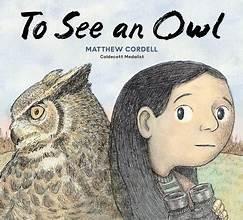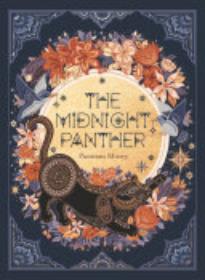Camouflage
49 Reviews
(2)
K-3
This picture book's front matter offers an immediate hook: "When will I find you?" Narrator Janie, a young birder with a particular affinity for owls, is searching a wintry wooded area; careful viewers will notice that she has just passed an owl camouflaged in a nearby evergreen tree, underscoring the elusive nature of these creatures. Janie reads about owls; draws illustrations of them; keeps an owl journal; makes a map of the places she's looked; and eagerly seeks information from her teacher, a fellow birder. But she has never spotted one. Throughout the seasons, she and her mother silently walk the woods and visit the shore and even a cemetery, but no owls in sight. Cordell's tranquil landscapes, rendered in pen and ink and soft watercolors, reinforce the character's quiet determination as she continues her search. Her physical characteristics (particularly while bundled up in a puffer jacket, hat, and mittens, with binoculars) resemble those thrice ascribed to owls -- "Perfectly stout. Large, round eyes. Silent, knowing faces" -- giving a visual reinforcement to her connection to these "birds of the night." Both compelling and informational, the story of Janie's quest, like the experience of finally sighting a pair of owls, is "magic."
Reviewer: Betty Carter
| Horn Book Magazine Issue:
January, 2025
(1)
K-3
A gentle panther loves the forest, but he's afraid to scale the tall trees and feels different from the other majestic cats. He admires Tiger's bold stripes, Lion's bright mane, and Leopard's dazzling spots. The panther collects feathers to mimic Lion's mane, but Wind blows them away, telling Panther he doesn't need them. He uses sticky pollen to give himself stripes like Tiger's, but Rain washes them away. When he attaches leaves to his fur to resemble Leopard's spots, Sun dries them out and they fall off. Disheartened, the panther turns to Moon. Enchanted by the moonlight, the panther forgets his fear and climbs high above the trees. Moon points out that Panther has a special gift "to be the color of the night," and, awestruck by the beauty of the night sky, the protagonist embraces his true self as a midnight panther. Mistry's intricate patterns, reminiscent of indigenous South Asian art forms, teem with life and serve as the perfect backdrop for the panther's dark coat. The fable-like story unfolds to show how the panther's timid nature and self-doubt slowly grow into self-confidence. Mesmerizing visuals underline the beauties of nature and of embracing oneself.
Reviewer: Sadaf Siddique
| Horn Book Magazine Issue:
January, 2025
(3)
K-3
Illustrated by
Britta Teckentrup.
Unlike the other chameleons, Leon can't seem to change color to match his surroundings. Readers are interactively encouraged to count, whisper, smile, and more as neon-orange Leon searches for an environment (green jungle? yellow desert?) in which his brilliant glow will fit. Teckentrup's bold digital illustrations play with variations in shade and texture, demonstrating the many ways an animal can blend in--or not, in Leon's case.
Reviewer: Erica Wetter
(3)
K-3
Illustrated by
Diana Schoenbrun.
Sam is determined to stand out at one of the special days at school: "Take Your Octopus to School Day." Loosely rendered ink, watercolor, and charcoal-pencil illustrations picture Sam toting his pet, Thurgood, ensconced in a travel tank. Scientific details, such as camouflage abilities of the "cephalopod mollusk in the order Octopoda," add dimension to the lighthearted school story.
Reviewer: Sheila M. Geraty
(3)
4-6
Arnosky shares his observations of animals that use camouflage to blend into their surroundings. Excellent explanations highlight the ways that shape, texture, color, and adaptability help these animals survive. His signature combination of finely detailed pencil sketches and full-page acrylic illustrations showcase reptiles, birds, sea animals, and more, over several foldout spreads and in a variety of environments. Reading list.
Reviewer: Danielle J. Ford
(3)
K-3
Illustrated by
Victo Ngai.
Barton recounts how design patterns camouflaged British and American ships to confuse German U-boat submarines during World War I. Royal Navy lieutenant-commander Norman Wilkinson proposed that a dazzlingly painted vessel would prevent attackers from determining the ship's speed and direction. Ngai's mixed-media illustrations artfully capture some of the thousands of ships painted by men and women civilian workers during the era. Reading list, timeline.
Reviewer: Luther B. Clegg
(3)
K-3
Illustrated by
Andy Atkins.
Napoleon the chameleon is naturally good at disguising himself in the lush tropical rainforest setting. He blends in so well, however, that he's invisible to his friends. An accidental trick finally gets the other animals' attention. Napoleon's tale of persistence is brought to life in the lavishly detailed illustrations.
Reviewer: Paula M. Cairo
(4)
4-6
Searchlight Books: Animal Superpowers series.
Each book presents four to five examples of an animal adaptation or behavior, such as wood frogs' freezing to hibernate, with additional similarly adapted animals showcased in "Compare It" inserts. Explanations of each titular behavior are quite brief, but the extended discussions of an individual animal's related habits, complete with multiple photos of each in action, provide good detail. Reading list, websites. Glos., ind. Review covers these Searchlight Books: Animal Superpowers titles: Exploding Ants and Other Amazing Defenses, Thousand-Mile Fliers and Other Amazing Migrators, Trap-Door Spiders and Other Amazing Predators, Dancing Bees and Other Amazing Communicators, Frozen Frogs and Other Amazing Hibernators, and Walking Sticks and Other Amazing Camouflage.
Reviewer: Danielle J. Ford
(4)
K-3
Illustrated by
Wesley Robins.
Hold recto pages to the light to reveal animals hidden in each full-color picture; turn the page for a detailed black-and-white illustration of the camouflaged critter. The series' signature gimmick works well with this topic, though text on the back of each page also shows through. A variety of habitats are included, and a final spread revisits each with additional facts about the animal.
Reviewer: Gail Hedges
(3)
4-6
A clear and fascinating description of the work of wildlife biologist Scott Mills as he and colleagues study the worrisome effects of climate change on snowshoe hares, which depend on seasonal coat color changes for survival. Abundant and informative color photos, sidebars, graphs, and maps lend immediacy to the account. Ideas for reducing our carbon footprint are appended. Reading list, websites. Glos., ind.
Reviewer: Nancy Sheridan
(4)
K-3
Illustrated by
Giles Laroche.
Organized in five thematic sections, including "Sea Life" and "Mammals," nineteen pedestrian poems introduce animals whose physiology helps them use camouflage to avoid predators or to trick potential prey. The accomplished cut-paper illustrations don't take full advantage of the hiding premise (i.e., the featured animals are easy to see) but are engaging nonetheless. End notes about each species provide more information. Reading list.
Reviewer: Kitty Flynn
(3)
4-6
Some animals have evolved features that make them appear to be other animals, plants, or rocks; others use sound or behavior to mimic different species. Detailed explanations of the benefits of each characteristic are accompanied by descriptions of scientific research being done on specific creatures. Well-captioned color photographs portray the animals both in their environments and in laboratory settings. Reading list, websites. Bib., glos., ind.
Reviewer: Danielle J. Ford
(3)
K-3
National Geographic Readers series.
Brief chapters introduce newly independent readers to the titular subjects. Ugly highlights several animals' quirky physical adaptations. Coral includes some more nuanced information on reefs (e.g., a labeled diagram of reef zones). Bright photos, labeled and at times captioned, clarify textual content, while boxes featuring definitions and jokes increase the books' approachability. A quiz and picture glossary are appended. Review covers the following National Geographic Readers titles: Ugly Animals and Coral Reefs.
Reviewer: Rebecca Fox
(4)
K-3
Paired with simple rhymes, bold, colorful (if sometimes not very detailed) illustrations depict various spotted animals--both new and familiar--such as a buckeye butterfly, jaguar, calico crab, green anaconda, and Dalmatian. A section at book's end explains a little about each animal and why their spotted patterns are helpful in nature. A matching game is appended.
Reviewer: Aimee Chevrette Bear
(3)
K-3
Illustrated by
Ashley Barron.
Young Kyle, a three-toed sloth, leaves his mother for the first time to travel from the rainforest canopy to its floor. Why? His weekly trip to relieve his bladder and bowels. He's nervous, but, encouraged by other rainforest creatures, he succeeds. Colorful collages, some vertical, first hide then reveal his helpful neighbors including a parrot and whipsnake. Factual information is appended.
Reviewer: Gail Hedges
(4)
PS
Ehlert's attractive poetry book is here reissued as a small board book. The collage art, with sharp, clean colors on white backgrounds, reproduces well in the smaller size, but the print is quite small and the text itself is less suited to a toddler audience. Even so, the youngest listeners will be intrigued by the invitation to look closely at the animal world.
Reviewer: Maeve Visser Knoth
| Horn Book Magazine Issue:
July, 2010
(4)
K-3
I Like to Read series.
Lewin camouflages an animal for youngsters to find in each of eleven rainforest scenes. The language ("I am a reptile. Can you see me?") is largely, and appropriately, repetitive, but the challenge of decoding the key word before finding the animal in the illustration adds an extra burden to the target audience of beginning readers. A picture guide with species names is appended.
Reviewer: Betty Carter
(3)
K-3
Adapted to Survive series.
Clear, concise description along with interesting facts makes these animal-adaptation books strong picks. Independent readers can easily gather information from the text, compelling photographs, captions, and "Did You Know?" sidebars. "Challenge" questions at the end will expand understanding, and an activity asking students to imagine their own unique climbing or camouflaged animal adds a level of creative thinking. Reading list. Glos., ind. Review covers these Adapted to Survive titles: Animals That Climb and Animals That Hide.
Reviewer: Kari Allen
(3)
PS
Illustrated by
John Butler.
"Where is baby?" So begins an introduction to young animals' camouflage and protective characteristics: a baby deer with dappled markings, baby leopards' climbing abilities, baby elephants "fade behind a forest of legs," etc. Realistic acrylic and colored-pencil illustrations picture varied species from the natural world--including the human baby, depicted on a concluding gatefold. "More About Babies" supplements the simple informational text.
Reviewer: Sheila M. Geraty
(3)
K-3
Here's a Where's Waldo?–like package with a purpose: double-page spreads of seven ecosystems contain hidden animals with only the total number of camouflaged animals as a clue. Each spread, from Everglade swamp to English deciduous forest, is followed by a numbered answer key that includes brief facts about animals' camouflage mechanisms. Careful gouache illustrations validate the information in detail and scale. Ind.
Reviewer: Frieda F. Bostian
49 reviews
We are currently offering this content for free. Sign up now to activate your personal profile, where you can save articles for future viewing.
























